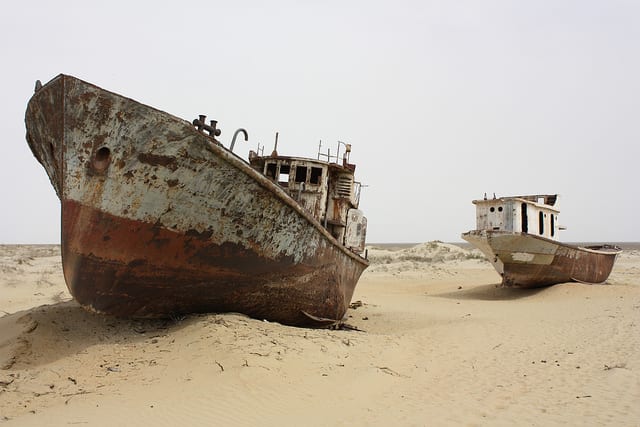 Image Courtesy of Arian Zwegers on Flickr.
Image Courtesy of Arian Zwegers on Flickr.
Central Asia: Aral Sea Disappearance Cause For Concern
The Aral Sea once supported fishing and agricultural populations along the borders of Uzbekistan and Kazakhstan. In the early 21st century, the Soviet Union diverted the Aral sea’s primary fresh water sources, the Syr Darya and Amu Darya rivers, for irrigation of their cotton fields. As a result, the sea has shrunk to two bodies of water: The North Aral Sea in Kazakhstan and the South Aral Sea in Uzbekistan. The disappearance of the Aral Seas has far reaching impacts on the communities that rely on the sea for its natural resources. Because of a combination of climate change and the drastic re-direction of water, the Aral sea changed from the fourth largest inland lake, to two bodies of water a tenth of its original size. This drastic environmental change forced farmers and coastal fishing communities to leave the Aral Sea basin and seek employment opportunities elsewhere, evaporating the local economy faster than the water.
Previously thriving agricultural communities along the coast of the Aral Sea have disappeared. The loss of the sea exacerbated the local environmental changes and accelerated insecurity in the region. A recent BBC article explains these issues for the people of Kazakhstan:
“Grass dried up, and the small freshwater lakes that once existed near the sea’s edge disappeared. Herds of antelope that used to roam the area dwindled to nothing. The summers became blisteringly hot, the winters bitingly cold… They spent half the year there in terrible conditions, without showers or toilets, infested with lice, and the rest of the year at home. As the sea receded, the climate began to change.”
While the water diversion by the Soviet Union cause the Aral Sea to shrink initially, climate change has accelerated the process. Hotter summers and colder winters due to climate change further the disappearance of the Aral Sea. Climate change was not the main cause of the Aral Sea’s disappearance, but recent droughts caused by climate change are speeding up the drying process. Mathew Barlow, an associate professor at the University of Massachusetts, Lowell, explains that, :
“While the diversion of river water is the main culprit behind the gradual but persistent disappearance of the lake, a drought in the area finally finished off the disappearing act of one of the lake’s remnants.”
Efforts to recover and replenish the South Aral Sea in Uzbekistan have wallowed with minimal success. The North Aral Sea however is being revived. An $87 million-dollar project, conducted by the World Bank in the late 1990s, is just starting to see the return of water and economic growth to coastal cities like Aralsk in Kazakhstan. The project constructed a 7.5-mile-long dyke that connects the North and South Areal Sea’s to reduce the amount of water flow between them. Improvements to the pre-existing channels of the Syr Darya river increased the flow of water into the North Aral Sea, rejuvenating the ecosystem and replenishing the Sea’s amount of water. Completed in the summer of 2005, the dyke surpassed the World Bank’s original expectations, leading to a 3.3m (10.8ft) water level increase over just seven months. The report originally estimated that an increase of that level would take upwards of 10 years. As a result the northern part of the sea improved, reviving the local fishing industry.
While the recent improvements are promising, climate change will make sustaining the local economy and surrounding communities increasingly difficult. Without increased attention to climate change, environmental disasters, like the disappearance of the Aral Sea will only grow, potentially causing further economic challenges. A greater emphasis must be made on the seriousness of these environmental calamities.





